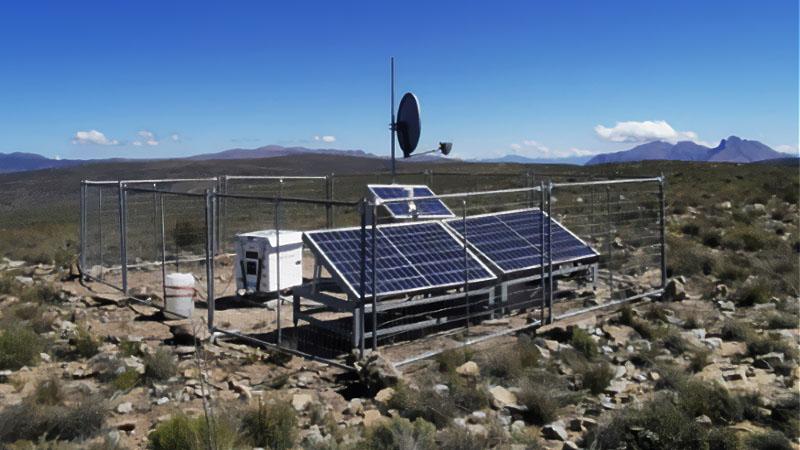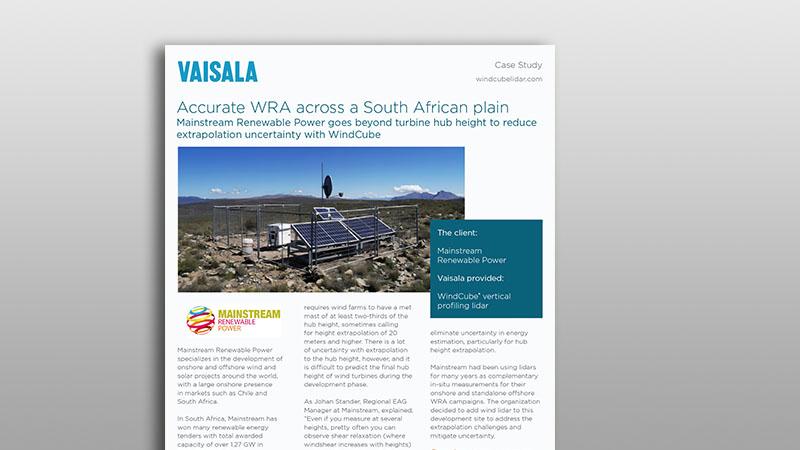Accurate WRA across a South African plain
Mainstream Renewable Power goes beyond turbine hub height to reduce extrapolation uncertainty with WindCube
The client: Mainstream Renewable Power
Vaisala provided: WindCube vertical profiling lidar
Mainstream Renewable Power specializes in the development of onshore and offshore wind and solar projects around the world, with a large onshore presence in markets such as Chile and South Africa.
In South Africa, Mainstream has won many renewable energy tenders with total awarded capacity of over 1.27 GW in RD5, REIPPPP. Their Dwarsrug wind farm in Northern Cape is in development with 120 MW planned capacity in operation by 2024.
Measuring wind at hard-to-predict hub heights
Mainstream had one met mast installed at Dwarsrug to conduct Wind Resource Assessment (WRA) campaigns. South Africa requires wind farms to have a met mast of at least two-thirds of the hub height, sometimes calling for height extrapolation of 20 meters and higher. There is a lot of uncertainty with extrapolation to the hub height, however, and it is difficult to predict the final hub height of wind turbines during the development phase.
As Johan Stander, Regional EAG Manager at Mainstream, explained, "Even if you measure at several heights, pretty often you can observe shear relaxation (where windshear increases with heights) and sometimes it doesn’t. For us, it is very important to mitigate that uncertainty and quantify the shear relaxation, if any, that allows us to be more confident in our estimations and take less risks in the bid."
Lidar measurements are commonly seen by independent consultants, project developers and financiers as the only way to eliminate uncertainty in energy estimation, particularly for hub height extrapolation.
Mainstream had been using lidars for many years as complementary in-situ measurements for their onshore and standalone offshore WRA campaigns. The organization decided to add wind lidar to this development site to address the extrapolation challenges and mitigate uncertainty.
Complementary accuracy for decreasing uncertainty
Mainstream added a WindCube vertical profiling lidar to the development site. With years of experience using WindCube lidars, the choice was easy for the organization because of the technology’s metrology and added value in every campaign they have used one. Obelisk, a Vaisala-trained Regional EAG Manager partner with local expertise and knowledge of the South African market, completed the lidar installation on the simple terrain.
Mainstream began by validating the WindCube using the onsite met mast for three months to detect any wind speed bias and take it into account in the actual measurement campaign. After the verification was complete, they conducted measurements at one location for at least 12 months to avoid any seasonal bias on the correlations. After 12 months, Mainstream may decide to change the measurement location or repurpose lidar for another measurement campaign.
"You can go beyond the hub height with lidar. Usually, you don’t know the size of rotor at the development stage of the project so it’s very helpful to know the wind speeds on the lower and higher tip height of the rotor to see how the wind changes across the rotor and to predict loads for turbine life period, which is beneficial for any wind project.”
Johan Stander
Dependable data for many uses
WindCube lidar is again proving itself in decreasing uncertainty through highly accurate measurements at hub height and beyond—up to 240 meters in this case. Mainstream is using it not only to reduce uncertainty and hub height extrapolation, but also as a measurement point independent from the met mast. This will prevent overestimating wind speeds that would be discovered later during the operational phase by reducing the horizontal extrapolation.
"WindCube lidars provide a good amount of clean meta data apart of measurement data like signal errors that can be very helpful when you need to filter out more data for customization,” said Johan.
The organization is convinced that lidar is a valuable asset in WRA campaigns. As a manager at Mainstream explained, "Lidar should increase data availability, and it will become universal because met masts require a lot of maintenance and carry the risk of working at heights; any accident at heights can be fatal, and that is 100% mitigated with the lidar."
Mainstream is looking forward to continuing advancing wind projects in South Africa using WindCube lidar.

